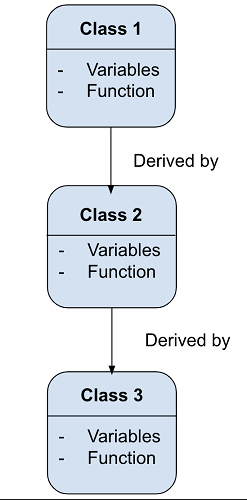Home »
Python »
Python Programs
Multilevel Inheritance Example in Python
Here, we are going to learn about the Multilevel Inheritance in Python and demonstrating the Multilevel Inheritance using a Python program.
Submitted by Shivang Yadav, on February 16, 2021
Problem Statement
We will see a program to illustrate the working of multilevel inheritance in Python.
Problem Description
The program will calculate the final salary of an employee from basic salary using multilevel inheritance.
Multilevel Inheritance in Python
Multilevel inheritance in programming (general in object-oriented program). When a base class is derived by a derived class which is derived by another class, then it is called multilevel inheritance.
The below diagram will make things clearer,

Class used in the program
All Class used in the program and the methods:
-
Class: Employee
- Method: getEmployee() -> gets user input from id, name and salary.
- Method: printEmployeeDetails() -> prints employee detail
- Method: getSalary() -> return the salary of the employee.
-
Class: Perks
- Method: calcPerks() -> calculates all perks using the salaries.
- Method: putPerks() -> prints all perks.
- Method: totalPerks() -> return the sum of all perks.
-
Class : NetSalary:
- Method: getTotal() -> calculates net Salary using perks and base salary.
- Method: showTotal() -> prints total salary.
Python program to illustrate multilevel inheritance
class Employee:
def getEmployee(self):
self.__id = input("Enter Employee Id: ")
self.__name = input("Enter Name: ")
self.__salary = int(input("Enter Employees Basic Salary: "))
def printEmployeeDetails(self):
print(self.__id,self.__name,self.__salary)
def getSalary(self):
return(self.__salary)
class Perks(Employee):
def calcPerks(self):
self.getEmployee()
sal=self.getSalary()
self.__da=sal*35/100
self.__hra = sal * 17 / 100
self.__pf=sal*12/100
def putPerks(self):
self.printEmployeeDetails()
print(self.__da,self.__hra,self.__pf)
def totalPerks(self):
t=self.__da+self.__hra-self.__pf
return (t)
class NetSalary(Perks):
def getTotal(self):
self.calcPerks()
self.__ns=self.getSalary()+self.totalPerks()
def showTotal(self):
self.putPerks()
print("Total Salary:",self.__ns)
empSalary = NetSalary()
empSalary.getTotal()
empSalary.showTotal()
Output
The output of the above program is:
Enter Employee Id: 001
Enter Name: John
Enter Employees Basic Salary: 25000
001 John 25000
8750.0 4250.0 3000.0
Total Salary: 35000.0
Python class & object programs »
Advertisement
Advertisement